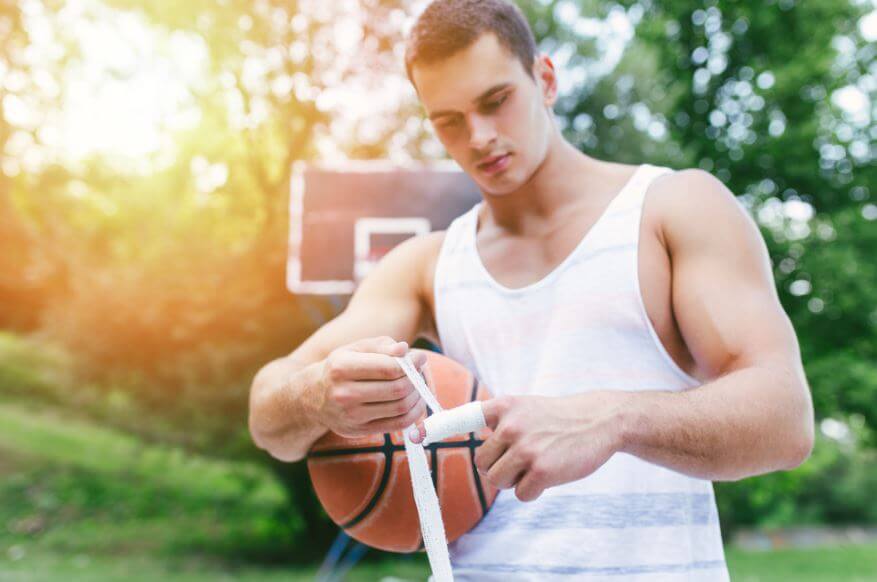The Most Common Injuries in Basketball

Basketball is one of the most popular sports in the world. It’s also one of the most physically demanding and consequently, potential injuries are always waiting to strike. In today’s post, learn about the most common injuries people suffer in basketball.
Basketball is undoubtedly a sport that offers great benefits for both your mind and heart. And one thing remains clear: the risk of injury is low and insignificant in comparison to all of its advantages. Besides, prevention and informing yourself about these injuries can further reduce your chances of suffering them.
What are the most common injuries in basketball?
1. Jammed fingers
Anyone who plays basketball will probably be familiar with the first injury on our list. Unfortunately, it’s all too easy to jam a finger. Jammed fingers can keep you away from the court for some time, even weeks.
More often than not, people jam their fingers when receiving a pass or when trying to grab a rebound. As a consequence of the force, swelling can occur in a joint, which comes hand in hand with pain and stiffness. Fortunately, these injuries usually only require one to four weeks to recover completely.
2. Sprained ankle
Basketball requires a lot of different techniques and footwork is one of them. Consequently, sprained ankles are also very common in basketball. Players can sprain their ankles when trying to outwit an opponent by changing their beat or when they land on their feet after jumping for a rebound.

There are three classes of ankle sprains: 1st, 2nd and 3rd degree. The intensity of the pain and how badly affected the ankle and ligaments are will increase with each degree, in addition to the recovery time.
3. Sprained knee
Sprained knees can occur with a sudden stop or a change in direction, with or without physical contact from the opponent. Similar to ankle sprains, the pain in knee sprains can focus on one area or generally affect the entire knee.
In addition, swelling may or may not be visible. If you suffer from a sprained knee, make sure you see a doctor and rule out any serious injuries that might require surgery.
4. Shoulder tendonitis
In basketball, the repetitive shooting and passing movements take their toll on the shoulders, which are an entire system of muscles, tendons, and ligaments.
The repetitive actions can lead to tendon inflammation or irritation, which is called “shoulder tendonitis“. People who suffer from it feel constant pain in their shoulders, especially when they lift their arms above their heads.
How can you prevent these common injuries?
If you want to avoid these injuries, make sure you follow our tips. First and foremost, warm up.
Warming up your body prepares your muscles for action. In addition, it also decreases the risks of suffering from any injuries.

Equally as important, stretch your muscles before and after every workout. Take your time and elongate all of the muscles and joints that see action.
On a different note, staying hydrated is also very important. Don’t forget to drink water at all times, especially if you’re playing in hot weather.
Lastly, if you love basketball but haven’t played in a while, tackle workouts slowly, gradually increasing the intensity over time. Listen to your body and don’t exceed your limits.
To wrap up, basketball is a great sport, physical mishaps included. But now that you know the most common injuries and how to prevent them, you can reduce your chances of suffering one and missing court time.
Basketball is one of the most popular sports in the world. It’s also one of the most physically demanding and consequently, potential injuries are always waiting to strike. In today’s post, learn about the most common injuries people suffer in basketball.
Basketball is undoubtedly a sport that offers great benefits for both your mind and heart. And one thing remains clear: the risk of injury is low and insignificant in comparison to all of its advantages. Besides, prevention and informing yourself about these injuries can further reduce your chances of suffering them.
What are the most common injuries in basketball?
1. Jammed fingers
Anyone who plays basketball will probably be familiar with the first injury on our list. Unfortunately, it’s all too easy to jam a finger. Jammed fingers can keep you away from the court for some time, even weeks.
More often than not, people jam their fingers when receiving a pass or when trying to grab a rebound. As a consequence of the force, swelling can occur in a joint, which comes hand in hand with pain and stiffness. Fortunately, these injuries usually only require one to four weeks to recover completely.
2. Sprained ankle
Basketball requires a lot of different techniques and footwork is one of them. Consequently, sprained ankles are also very common in basketball. Players can sprain their ankles when trying to outwit an opponent by changing their beat or when they land on their feet after jumping for a rebound.

There are three classes of ankle sprains: 1st, 2nd and 3rd degree. The intensity of the pain and how badly affected the ankle and ligaments are will increase with each degree, in addition to the recovery time.
3. Sprained knee
Sprained knees can occur with a sudden stop or a change in direction, with or without physical contact from the opponent. Similar to ankle sprains, the pain in knee sprains can focus on one area or generally affect the entire knee.
In addition, swelling may or may not be visible. If you suffer from a sprained knee, make sure you see a doctor and rule out any serious injuries that might require surgery.
4. Shoulder tendonitis
In basketball, the repetitive shooting and passing movements take their toll on the shoulders, which are an entire system of muscles, tendons, and ligaments.
The repetitive actions can lead to tendon inflammation or irritation, which is called “shoulder tendonitis“. People who suffer from it feel constant pain in their shoulders, especially when they lift their arms above their heads.
How can you prevent these common injuries?
If you want to avoid these injuries, make sure you follow our tips. First and foremost, warm up.
Warming up your body prepares your muscles for action. In addition, it also decreases the risks of suffering from any injuries.

Equally as important, stretch your muscles before and after every workout. Take your time and elongate all of the muscles and joints that see action.
On a different note, staying hydrated is also very important. Don’t forget to drink water at all times, especially if you’re playing in hot weather.
Lastly, if you love basketball but haven’t played in a while, tackle workouts slowly, gradually increasing the intensity over time. Listen to your body and don’t exceed your limits.
To wrap up, basketball is a great sport, physical mishaps included. But now that you know the most common injuries and how to prevent them, you can reduce your chances of suffering one and missing court time.
All cited sources were thoroughly reviewed by our team to ensure their quality, reliability, currency, and validity. The bibliography of this article was considered reliable and of academic or scientific accuracy.
- Manonelles Marqueta, P., & Tarrega Tarerro, L. (1998). Epidemiología de las lesiones en el baloncesto. Archivos de Medicina Del Deporte. Federación Española de Medicina del Deporte.
- Naismith, J. (2006). Lesiones en el baloncesto. Fisioterapia ALTHEA. Retrieved from https://doctorvillanueva.com/lesiones-en-el-baloncesto/
- Barcelona, F. (2009). Guía de Práctica Clínica de las lesiones. Apunts. Medicina de l’Esport, 164, 179–203.
- Franco Bonafonte, L. (1998). Fisiología del baloncesto. Archivos de Medicina Del Deporte.
This text is provided for informational purposes only and does not replace consultation with a professional. If in doubt, consult your specialist.








